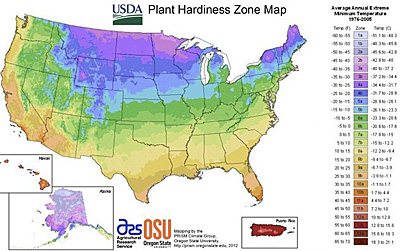Do you go blank when you see the brightly colored map of the United States broken into 11 zones? You are not alone but why not make friends with that map? It is very useful and not hard to understand. The map shows the country divided into 11 regions or zones based on the lowest average temperatures in the zone. Each zone is about 10o F colder than the zone immediately south of it. Some zones are further broken down into a and b to designate areas that are 5o F different in lowest average temperatures. (Click on the map to get an enlarged graphic.)
Recall that every plant has a range of temperatures at which it can grow. Hotter or colder, it will not do well and may die. The USDA map gives you an idea of where a plant may be able to grow based on the lowest temperature at which it can survive. Plants growing in a colder temperature will not do well and will probably die. For example, in my Piedmont North Carolina zone 7b (lowest temperatures 10o-5o F) garden I can grow beautiful, vigorous, floriferous crepe myrtle. If I move to Chicago in zone 5 (lowest temperatures -10o to -15o F) with my crepe myrtle it will die because of the cold temperatures there. On the other hand, I will not be able to grow pineapple or coffee trees that thrive in zone 10a (lowest temperatures 30o-35o F) because they cannot survive temperatures below 30o F. Sometimes a zone will have areas in it that are colder or warmer than the rest of the area. These areas, or microclimates, are created by many factors such as snow cover, cold air drainage, or presence of buildings. The thing to remember here is that the hardiness zone represents the lowest temperature in the area and any plant growing there must be able to survive that temperature.
The next hurdle to using hardiness zones may be figuring out what zone you are in and that is easily determined by using the U.S. Department of Agriculture Zone finder found at http://planthardiness.ars.usda.gov/PHZMWeb/. Just type in your zip code and you will get your zone and a list of plants that will grow in your zone.
Once you determine the zone in which you are gardening you can use the USDA zones to choose your plants. Look on the tag that comes with the plant at the nursery or the description of the plant in a catalogue and it will usually give the hardiness zones for the plant. I have noticed recently that some of the nurserymen are giving the minimum temperatures at which the plant will grow instead of the zone. I hope this is not a way of fooling the buyer into buying plants that are unsuitable for the area. Try to memorize the zone AND the average lowest temperature in that zone.
At this point some of you may have noticed that not all places in a zone are even remotely similar. For example Tucson, Arizona, Seattle, Washington, and Myrtle Beach, South Carolina are all in zone 8 but have very different climates. Similarly, Phoenix, Arizona and Orlando, Florida are both in zone 9b but you would not expect to see Saguaro cacti in the Orlando area. This, of course, is due to the fact that there are many other factors involved in a plant’s good health such as its heat tolerance, drought resistance, and soil requirements.

